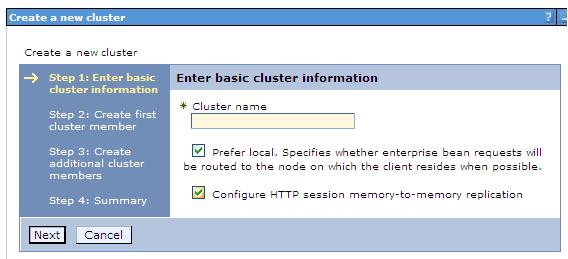Create a cluster: Basic cluster settings
To view this console page, click...
Servers | Clusters | New

- Cluster name
- Name of the cluster. The cluster name must be unique within the cell.
- Prefer local
-
Specify that the node scoped routing optimization is enabled or disabled. The default is enabled, which means that EJB requests are routed to the client node when possible. Enabling this setting improves performance because client requests are sent to local enterprise beans.
- Configure HTTP session memory-to-memory replication
-
Specify that when the cluster is created, a memory-to-memory replication domain is created for each of the members of this cluster.
If a replication domain is created, it is given the same name as the cluster and is configured with the default settings for a replication domain. When the default settings are in effect, a single replica is created for each piece of data and encryption is disabled. Also, the SIP container and Web container for each cluster member is configured for memory-to-memory replication.
To modify the replication domain settings, in the console, click...
Environment | Replication domains | replication_domain_name
The default mode setting for the replication domain is Both client and server. In this mode, all data sent to either the client or the server is replicated. This setting is good for an environment that has a middle to low traffic load.
If your environment has a high traffic load, you should change the replication domain mode setting to either Client only , or Server only, because these settings provide better scaling. In Client only mode, only data sent to the client is replicated. In Server only mode, only data sent to the server is replicated.
To modify the mode setting for a replication domain:
- In the console, click...
Servers | Application servers | server | Container settings | [SIP Container Settings | Web Container Settings] | Session management | Distributed environment settings | Memory-to-memory replication

- Select a different mode. It does not matter whether you change the mode under the SIP container or the Web container because the same replication domain settings apply to both containers.
If you change any of the replication domain settings for one cluster member, including the mode setting, you should change them for all of the other members of the cluster.
- In the console, click...
Related concepts
Clusters and workload management
Related tasks
Create clusters
Related Reference
Create a cluster: Create first cluster memberCreate a cluster: Create additional cluster members
Create a cluster: Summary settings